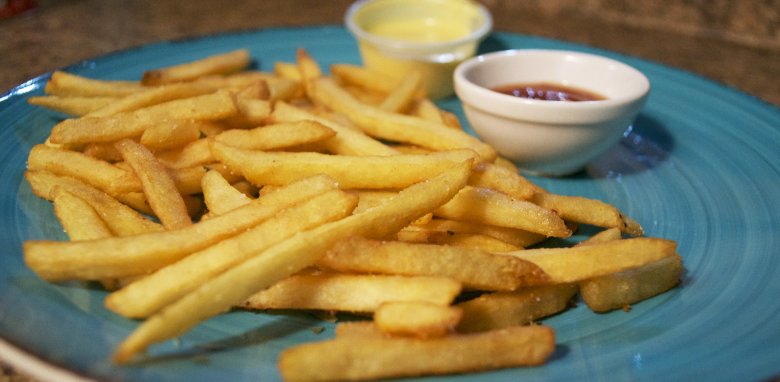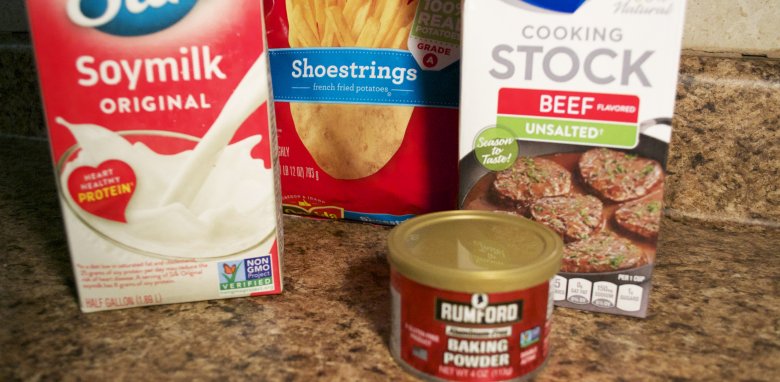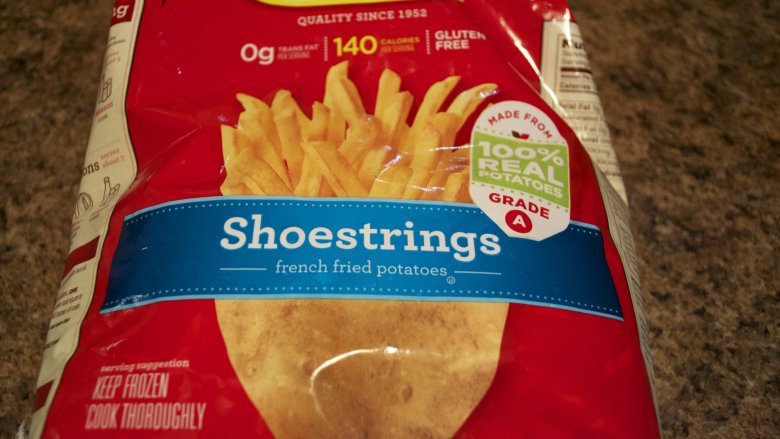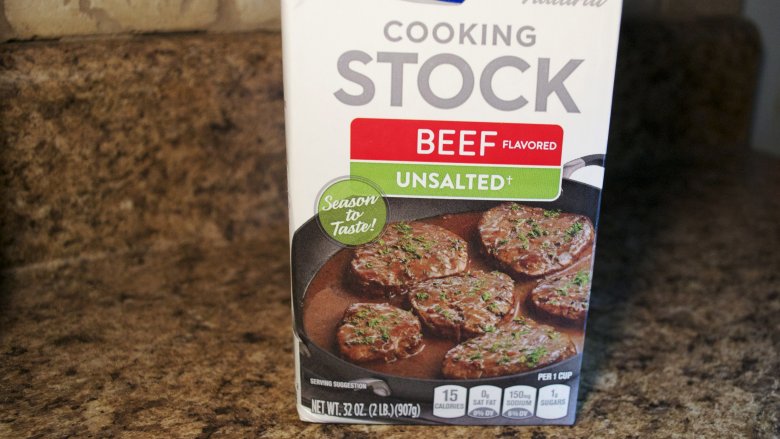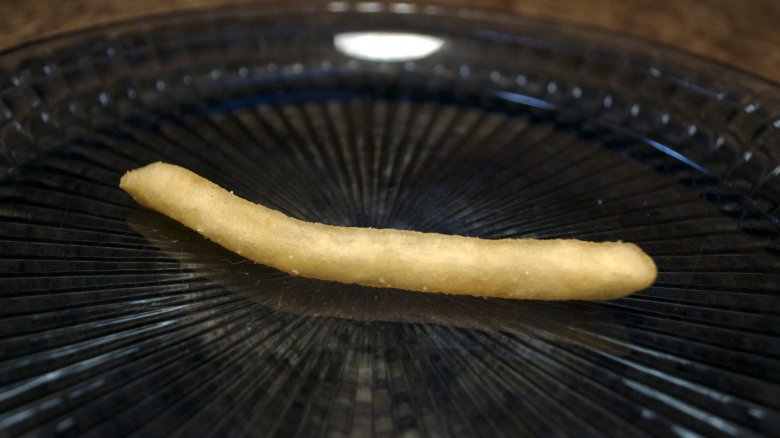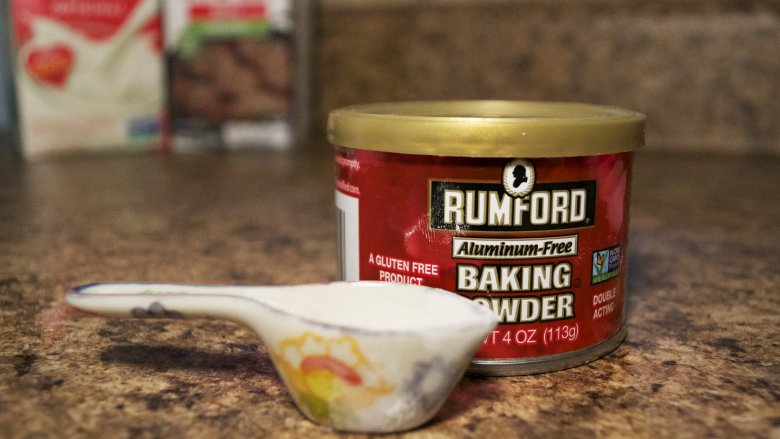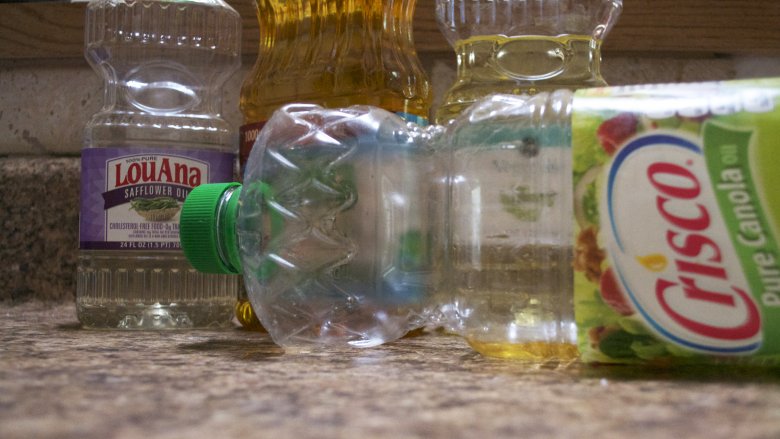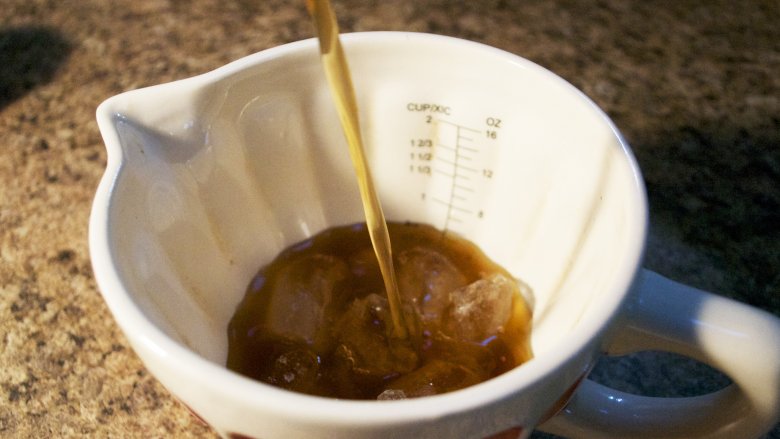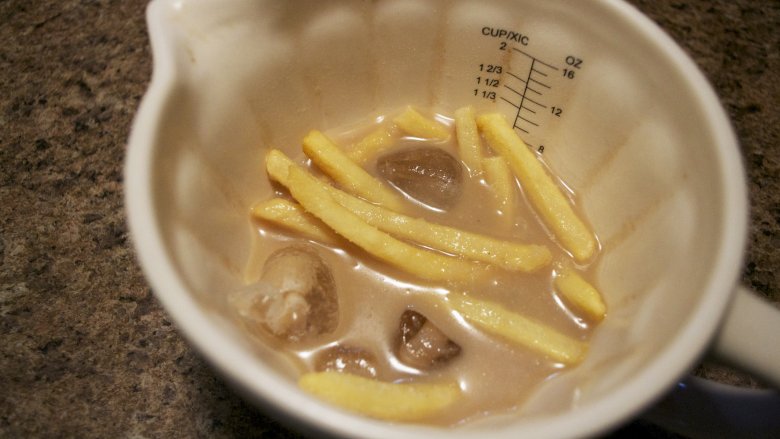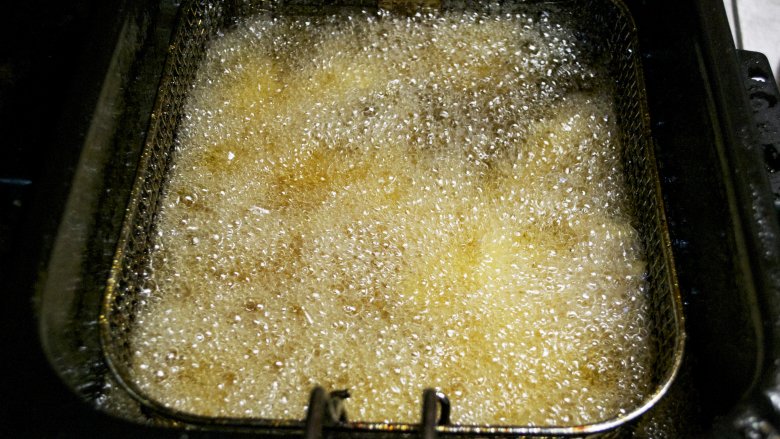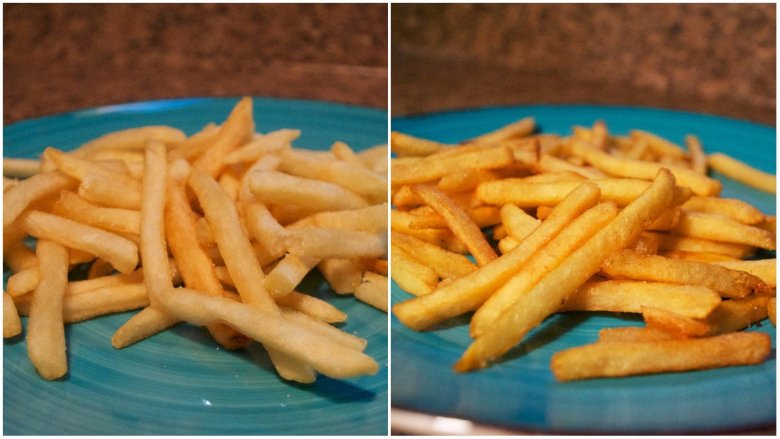Copycat McDonald's Fries Recipe
Is there anything better than McDonald's French fries? Well, yeah, but really, the number of things better than fries from the Golden Arches is pretty slim. McDonald's fries consistently are voted at the top of America's favorite quick-serve fries. What is it about those fries that makes them so delectable? And it's just fries, so how hard can it be to replicate them? The answer is easy, and you won't believe it — but not in that order. It's probably going to shock you when you see what you need to make a perfect copycat of McDonald's fries.
Let's get cooking!
Here's what you need to create your own at home McDonald's fries: shoestring frozen French fries, unsalted beef stock, baking powder, soy milk, soybean oil (if available), canola oil, and corn oil. Simple, but not what you'd expect. You'll get the full list of ingredients and step-by-step instructions at the end of this article.
The fries
You're not going to make your own home cut fries. You think you want to, but you really don't. It's a gigantic pain to cut your own fries from a potato, and McDonald's uses high speed water to blast their potatoes through a giant cutter — you probably don't have one of those at home. There is zero value in cutting your own fries at home. Zippo. You can head down to your local grocery store and find exactly what you need.
McDonald's fries are shoestring fries, with a few more items added in. A few different companies make them, just make sure they have the ingredient that we're looking for: dextrose.
Dextrose and glucose are essentially the same thing. But in fries talk, dextrose — which is corn syrup in its simplest form — gives the golden color to the finished product. By getting a shoestring bag you're getting the dextrose included, which means you don't have to give the fries a corn syrup bath.
You still want to make your own fries? Well, guess what, that's not what McDonald's does. In a video hosted by Mythbusters' Grant Imahara, the entire process is revealed. McDonald's flash freezes their fries, which means every Mickey D's cooks from frozen. So why can't you?
The secret ingredient
The reason people adore McDonald's fries is their unique flavor, and you might be surprised where that flavor comes from. The official site admits to it, but when word first hit the press, those with religious reasons for avoiding meat were not happy. McDonald's fries are not vegan or vegetarian. The official site tells you that it's natural beef flavor, however, you'll note that the fries are not cooked in any beef tallow. A lot of "copycat" recipes will tell you to just throw a little beef tallow into the oil and insto-presso, you've got yourself some McDonald's fries. But not so fast, my friend; McDonald's tells you the natural beef flavor is added to the fries, not the oil, so throwing some beef fat in the oil is not going to cut it.
The unique McDonald's taste
Have you ever tasted a McDonald's french fry? I mean really tasted it? Given it the "snobby wine treatment" — swishing the flavors around so it engulfs your tongue, and you can pick out everything going on inside that potato? So what is it that gives McDonald's that flavor? Well, how good is your palate? Can you taste the dairy McDonald's fries? It's subtle, but it's there. T
he official recipe tells you what it is too: hydrolyzed milk. Do you know what that is? Baby formula. Indeed, for babies with lactose intolerance, it's the go to milk product. If you don't feel like investing $30 in a can of baby formula, we have a simple workaround — soy milk. All we're doing is adding the flavor of milk without the actual milk. This will be a suitable substitution.
The dry binder
Sitting right there in the recipe is our old friend sodium acid pyrophosphate — or baking powder as we know it. You may think you don't need baking powder, especially with some frozen fries, but we need a little something to help the liquid stick, and baking powder — with its bubbly chemical reaction — will do exactly that. Besides, it is the same thing McDonald's uses, so that's good enough for me.
The oil
McDonald's doesn't tell you exactly what their oil is — only that it's a blend of canola oil and soybean oil — and some corn oil mixed in, in the form of "vegetable oil" — but no peanut oil.
Similar to when I made Long John Silver's fish, I couldn't find soybean oil. So I'm using a blend of canola and safflower oil, corn oil, and an extra ingredient. My guess is that McDonald's isn't changing their oil out for every fry batch, so I'm using some leftover canola oil I have. I'm hopeful this blend will get me close to the right cooking oil flavor McDonald's uses.
Make the brine
Can you actually brine a potato? Well, we're certainly going to try. The flavor that McDonald's adds to their fries occurs prior to the cooking process. We'll do the same in an unconventional way. Add a quarter cup of ice to a measuring cup. To that, add a half cup of unsalted beef stock. Everything at McDonald's is super salty anyway, so pealing off a little bit of salt here will help on the back end. Add a quarter cup of soy milk, and a half teaspoon of baking powder. Give it a little twirl, and get ready to do something you never thought you'd do.
Dunk your fries
Everybody in the pool! That's right, give your fries a little bath in the brine — just drop them in and turn them over once. Then quickly evacuate them from the brine and put them on a flat tray and then park them back in the freezer for five minutes. McDonald's fries come flavored and frozen, so a quick bath and then a deep dive into the oil won't give us what we want; we need to get the fries to have the brine concoction stick, and five minutes in the chill chest will get it done.
The fry
Get your oil to 375 degrees Fahrenheit, and drop in your fries. At that temperature, and with the very thin shoestring fries, the cooking time will be rather quick. Everything I could find from "alleged McDonald's employees" online says that the fries cook for three minutes, 10 seconds. Three minutes, 10 seconds in my fryer produced overdone fries. After a few (a lot) of attempts, the perfect cooking time for fries at that temp is 2 minutes, but keep an eye on them in case you need to go longer (or shorter) in the cook time.
As soon as they're done, get them out and salt them — McDonald's salts the daylights out of them, but you can apply as much as your delicate sodium loaded body can take.
How close are we?
You're not going to believe this, but these taste exactly like McDonald's fries. Five people (counting myself) tried the fries. Two of the testers didn't know they weren't McDonald's fries — and they couldn't tell the difference. To the other three, the flavor was dead on, but the difference was in the oil. It's just flat out impossible to figure out exactly what the mix is on McDonald's oil, unless they come out and officially tell you what it is. But as far as the flavor goes, you can taste that slightly dairy flavor that McDonald's has, along with the hint of beef.
As you can see in the image, the McDonald's fries are on the left, and the perfect copy is on the right. The homemade fries came out a lot more golden-brown than the ones from the restaurant, but that's just a difference in preference.
Directions
It's probably going to shock you when you see what you need to make a perfect copycat of McDonald's fries, but it's easier than you think to replicate.
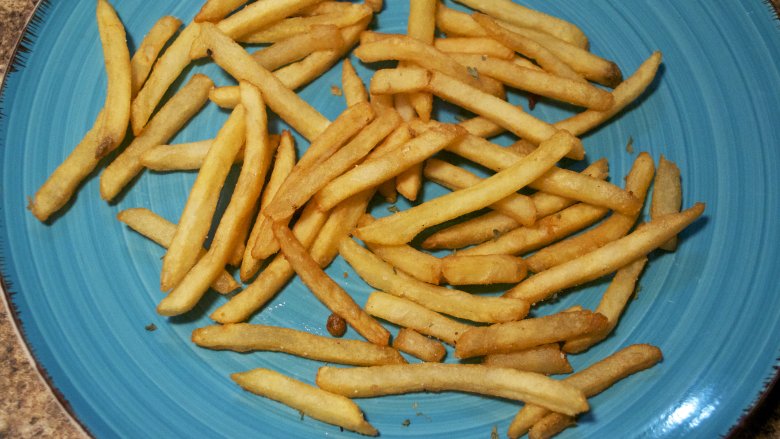
Ingredients
- Canola Oil
- Soybean oil or safflower oil
- Corn oil
- ¼ cup ice
- ½ cup unsalted beef stock
- ¼ cup soy milk
- ½ teaspoon baking powder
- 1 bag of shoestring fries (26 ounces)
Directions
- Heat oil to 375 degrees Fahrenheit.
- Combine ice, beef stock, soy milk and baking powder in a bowl, and mix until combined.
- Place fries into the brine, and remove after a few seconds.
- Put brined fries back into the freezer for five minutes.
- Drop fries into oil, cook for 2 minutes, or until the reach your desired doneness.
- Remove and enjoy!
Nutrition
| Calories per Serving | 410 |
| Total Fat | 22.0 g |
| Saturated Fat | 4.0 g |
| Trans Fat | 0.3 g |
| Cholesterol | 1.5 mg |
| Total Carbohydrates | 48.4 g |
| Dietary Fiber | 4.2 g |
| Total Sugars | 1.3 g |
| Sodium | 707.1 mg |
| Protein | 5.1 g |
